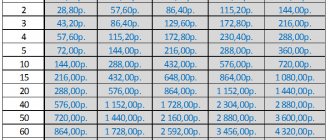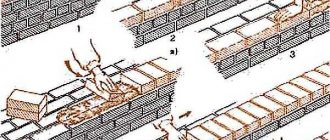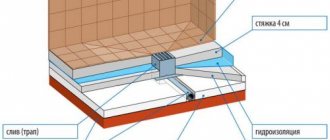The cost of ceramic tiles for indoor finishing work can be quite high. Therefore, it is very important to carry out correct tile calculations. This will help you save on the purchase of ceramics and reduce waste.
It is necessary to carry out calculations before purchasing the material in order to know exactly how much ceramics will be needed for a certain room. There are two ways to calculate the amount of tiles for a kitchen, bathroom or toilet: using an online calculator and manually.
Before gluing tiles, preliminary calculations must be made Source krovati-i-divany.ru
Calculation methods
Using a calculator will make the calculations much faster, but the results may be somewhat inaccurate. Therefore, when buying expensive luxury tiles, it is better to independently check the result obtained on the calculator.
Before starting the calculation, you need to determine:
- layout type;
- tile colors and their quantity;
- the need to use decorative elements;
- the presence of a pattern to which the material will need to be adjusted;
- tile size.
Advantages of project design
By ordering a free design project in the Art Real salon, you get 2 advantages:
- a developed design solution that takes into account the characteristics of your premises
- an exact indication of all tile articles and the required quantity.
With a free design project you save your time and money. In addition, you will be able to find out how the tiles will look in the interior even before they are laid. You can order a free design project by phone.
Tags: Fap , Peronda , Tiles , Ceramic tiles , For walls , For floors , Porcelain tiles , Universal , Decor , Panels , Peronda serenity , Fap Pop Up , Basic tiles
Why and how to calculate tiles for the bathroom? This is necessary to purchase the required volume of building materials: you will not overpay for unused material, and the money saved can be spent, for example, on purchasing tile adhesive.
Layout type
There are three layout options:
- Classical.
The room is divided horizontally into two parts. They are separated by a border and differ in color. The lower part is usually made dark, and the upper part lighter.
Classic layout Source profiplitka.ru
- Plain.
Tiles of the same color are used. As a rule, the presence of decor is assumed.
Plain layout Source eto-vannaya.club
- Combined.
For the layout, tiles of several colors are selected, most often three.
Combined layout Source otdelkino.ru
Method of calculation using a calculator
To calculate tiles for a room using a calculator, you must enter the following data:
- room parameters;
- the area of the door, which should be subtracted from the total area;
- dimensions of the bathtub, the need to line the ends and floor under the bathtub;
- dimensions of one element;
- the required reserve is best if it is 5-10 percent.
See also: Catalog of companies that specialize in finishing materials and related work
Surface preparation
A smooth, pre-prepared surface facilitates and speeds up the process of tiling.
If the floor is uneven by 1-2 cm, an experienced technician does not need preliminary leveling. If the unevenness is about 2-3 cm, it is best to level the surface with a self-leveling poured floor. The cement mixture diluted with water is evenly distributed over the entire area using a needle roller. For differences from 3 to 10 cm, it is recommended to make a cement screed with sand and with the addition of expanded clay, if the curvature of the floor is above 10 cm. After complete hardening, finishing work can continue.
The alignment of vertical surfaces requires special attention, since with a diagonal pattern, the bumps and curvature of the walls are especially noticeable. Minor wall defects are eliminated with putty; in case of complex distortions, it is recommended to cover the perimeter of the room with plasterboard.
The surface of the ceiling must be cleaned of loose plaster and whitewash, grease stains and glossy oil paint must be washed off. The seams between the slabs, cracks and irregularities should be filled with putty.
The adhesion of tiles to the surface being glued is much higher when using special primers. Additionally, after the primer has dried, you can apply a thin layer of liquid tile adhesive to the surface to be glued.
Calculating tiles without a calculator
The amount of ceramics must be calculated manually in the following order:
- Measure the parameters of the walls. If you are going to cover the bathroom screen, you need to find out its dimensions.
- Calculate the area of laying ceramics.
- Subtract from it the dimensions of the door, window, bathtub.
- Calculate the area of one tile.
- Divide the coverage area by the area of one element.
- Take into account the presence of borders and decor. Subtract them.
- If tiles of different colors are used for cladding, it is better to calculate the required material according to the sketch.
Add a margin of 5 - 10 percent. It will be needed if any part of the tile turns out to be defective or damaged during the installation process.
The tiles under the bathroom are not visible Source livemaster.ru
Advice! The part of the floor located under the bathroom can be ignored when calculating the required amount of material. The lack of coating will not be noticeable, but you can save money when buying ceramics.
Calculation of tiles. Why you need to take extra, how to calculate tiles for the bathroom area
Tile is the most suitable material for finishing sanitary premises, but it is also quite expensive. Therefore, in order not to have to buy more or throw away excess, you need to correctly calculate the tiles for the bathroom.
Correct calculation of tiles during repairs allows you to save not only time spent on purchasing missing materials, which, it should be said, may not be in the store, but also money that will be spent on surplus.
In order to calculate the amount of tiles for the bathroom, you first need to answer the following questions:
- What type of installation will you use;
- What color scheme do you plan to use;
- Will it be necessary to adjust the drawing; Will you lay only tiles on the walls or add decorative elements to the decoration?
By room area
This method seems to be the simplest because it is the most understandable. It is most suitable for tiling with single-color tiles of the same size.
Important! If the walls are uneven, tiles should not be laid along them. The floor covering is carried out along a specially laid horizontal line. Then the main part of the ceramics is laid, and only after that the remaining areas and near the walls are filled with small pieces of tiles.
How to calculate the number of tiles per floor based on the area of the room:
- You need to calculate the area of the room: multiply the length by the width. Measurements are taken with a long tape along the walls.
- Add approximately 5-10 percent to the area of the room so that there is a supply of tiles in case of defects or cracks.
- Divide the resulting value by the area of one tile.
- This will give you the number of elements needed to renovate the room.
Important! When receiving a fractional value, it must be rounded up. Otherwise, there may simply not be enough tiles.
Direct method of laying tiles on the floor Source stroimmaster.ru
Features of calculating the percentage of waste
On the Internet there are a lot of calculators for calculating the required amount of material. But you can only see the program shell and the final result from the entered data. How is the tile calculation done and is it correct?
The defect can manifest itself only after installation after a not so long time
The first question that arises is what percentage is taken for defects and other unforeseen cases during repairs? There is a value of 5%, which is as close as possible to reality. That's why:
- Suitable for tiles that do not have manufacturing defects, that is, all the material purchased is suitable for work. To do this, you should unpack each pack and look for defects (chips, cracks). There can also often be differences in shade that are very noticeable.
Attention! Different batches of material may have differences in size and shade, so it is worth buying products in sufficient quantities at one time.
- The dimensions should be no more than 20, 30 cm. If the module is large, then its waste area will be correspondingly larger.
- Drawing. For a simple design, it doesn't matter how you arrange the tiles. If, for example, a pattern is formed from 4 tiles, then the percentage of waste will increase several times.
But there are other points that may have been missed: often the area of the room is calculated inaccurately. This may arise due to rough calculations or due to the fact that the room itself may have an elongated, non-rectangular shape.
Therefore, can a waste percentage of 5% be considered accurate? Probably not. You need to take at least 7%, and even 10%. In this case, at least a square meter is guaranteed to remain, which can be saved for cosmetic repairs in the future.
Some people, to reduce waste, start laying tiles, but this method is not entirely reliable. Often defects begin to be observed during finishing cladding.
If a panel is laid on the floor using a contour of thinner tiles, then this will need to be taken into account. We can conclude that it is better to buy a little more once than in insufficient quantities. Finding the same tile later will be problematic.
By number of rows
There is another method for calculating the required material for laying ceramics on the floor. It is based on determining the number of rows of tiles. To do this you need:
- Measure the parameters of the room.
- Find out the dimensions of one tile.
- Divide the length of the room by the length of one element. The resulting number is the number of rows.
- Divide the width of the room by the width of one tile.
- If necessary, round values up.
- Add about 10% to them for reserve.
Piece method
This method is usually used if expensive tiles are purchased for installation or a pattern is created. This is due to the fact that when counting material individually, the error is minimal.
The process of laying floor tiles Source goodwood.spb.ru
Important! For laying tiles diagonally, this method of calculating tiles is not suitable.
The process is painstaking, but at the same time simple.
How to count tiles this way:
- We need to find out the dimensions of the room.
- Measure the parameters of one installation element.
- Count the number of rows and elements in each row.
- Multiply the resulting numbers. The value will be the number of elements needed to cover.
- Then draw a diagram of the floor covering and determine how many tiles of a certain color will be needed.
- Subtract the number of elements of a non-primary color from the total number.
- You will get several meanings. According to them, you will need to buy a certain number for each type of coverage.
Seam width
Seams can be from 1 to 10 millimeters wide. It depends on the type, geometry and size of the tile used. As a rule, the seam width is 2 millimeters.
Grouting process Source otlichnyjremont.ru
When performing the correct layout, the width and length of the seams can be ignored.
For example, there is a wall 1.5 meters long and a tile 0.4 meters long. Algorithm of actions:
- Measure the length of the wall - 1.5 meters.
- Calculate how many meters you can cover with whole uncut tiles: 0.4 * 3 = 1.2 meters.
- Subtract one tile: 1.2 – 0.4 = 0.8.
- Subtract this size from the length of the wall: 1.5 – 0.8 = 0.7 meters.
- Divide into two parts because the tiles will be cut twice equally at the edges: 0.7 / 2 = 0.35 meters.
- Laying should begin from the center.
- Lay two 0.8 meter tiles and two cut tiles at the edge - 0.35 meters. The result will be 1.5 m. Even if the seams reach one centimeter, this will not change anything. The trimmings will probably become a little smaller.
Bathroom wall cladding
To calculate the number of tiles for tiling the bathroom walls, it is better to carry out calculations separately for each wall.
For example, 270 cm (wall height) divided by 30 cm (tile height) = 9 elements in one row in height. 150 cm (surface width) divided by 20 cm (product width) = 7.5 – round up = 8 pieces in width. We multiply 9 by 8, we get - 72 units measuring 30x20 cm are needed for one wall 150 cm wide. Using similar calculations for a wall 170 cm long, we get the result - 81 tiles.
Taking into account the doorway
To calculate the amount of tiles required for cladding the wall in which the door is installed, it is necessary to subtract the amount that corresponds to the dimensions of the doorway from the number of elements for the opposite wall. For example, divide 200 cm (the height of the doorway) by 30 cm (the height of the tiles), we get 6.7 - round down = 6 pieces in height; Divide 70 cm (the width of the opening) by 20 cm (the width of the product), we get 3.5 - round down = 3 pieces in width. We multiply 6 by 3, we get 18 pieces, which we subtract from (for example) 81, we get 63 pieces. If you will completely cover the wall next to which the bathtub will be installed, then it is easy to calculate the number of tiles on it. If you do not plan to tile the space occupied by the bathroom, then the calculation for this wall is carried out similarly to the calculation for the wall with a door.
Briefly about the main thing
Before purchasing ceramic tiles, you need to calculate the required amount of material so that it is enough for the entire area of the room. This can be done in two ways: manually and using an online calculator.
The amount of ceramics required for renovation is influenced by the area of the room, the dimensions of the doors, windows and bathroom, the type of installation, the number of colors of the finishing material and other factors.
To calculate floor tiles, 5 methods are used: methods based on the area of the room and the number of rows, counting when laying diagonally and the piece method, combined calculation.
If you do not want to carry out the calculations yourself, when purchasing material, you can contact the store manager. It will help you calculate the required amount of materials for the room. To do this, you will need to first take measurements of the room.
Software option
If calculating tiles seems too complicated to you, you can simplify the task. There are quite a few services on the Internet that allow you to determine the amount of building materials online. For those who do not have constant access to the Internet, but want to entrust the numbers to professionals, we can recommend other options.
There are a number of software products that allow you not only to calculate the amount of building materials required for repairs, but also to see how well the selected elements fit together in the future interior.
This is VisiCon - a program produced by GrandSoft LLC and presented in two versions: for home and for commercial use. The demo version of the program can be downloaded from the official website. However, it should be taken into account that tile calculation is only available in the commercial version, which means it will become available only after registering the program.
The second option is the “Tile” program. This is the brainchild of Studio Compass LLC. You can download the free version of the program on SoftPortal.com»>website.
You can get all the necessary information on laying ceramic tiles.











